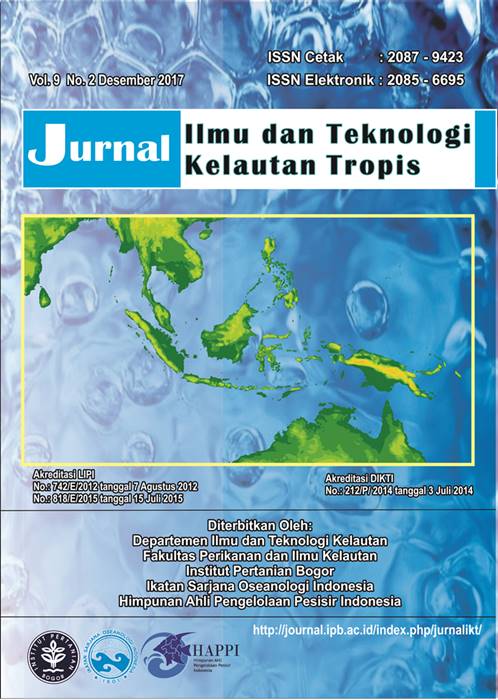VARIATION OF VOLUME TRANSPORT AND VARIABILITY OF CURRENT IN KARIMATA AND GASPAR STRAITS DURING 2010-2014 BASED ON NUMERICAL MODELING
Abstract
Karimata Strait located between Kalimantan and Bangka Islands, while Gaspar Strait located between Bangka and Belitung Islands. Volume transport variations through Karimata and Gaspar Straits during 2010-2014 were studied using three-dimensional numerical model of HAMburg Shelf Ocean Model (HAMSOM). Simulated area is located in 1°0′0′′N - 4°30′0′′N and 104°0′15′′E - 110°30′0′′E with a horizontal resolution of 0.5′ (about 0.94 km). The correlations value of current velocity from model with observation is quite high i.e. 0.85 for zonal component (u) and 0.89 for meridional (v) with 95% of significance level. The results of signal analysis showed that the volume transport is strongly influenced by the seasonal period. In addition to seasonal wind, there was also weak and medium phase of El Niño and La Niña during 2010 - 2014 that affected volume transport. The average volume transport from 2010-2014 through Karimata and Gaspar Straits are -2.75 Sv and -1.98 Sv, respectively (1 Sv = 106 m3/s). The negative value shows the southward volume transport, while positive to north. Total transport to south indicates that there are may be due to parts of Indonesia Through Flow (ITF) flow through South China Sea, Karimata Strait, and Gaspar Strait to the Java Sea.
Keywords: volume transport, Karimata Strait, Gaspar Strait
Authors
This work is licensed under a Creative Commons Attribution 4.0 International License.
Jurnal Ilmu dan Teknologi Kelautan Tropis i is an open-access journal, meaning that all content is freely available without charge to the user or their institution. Users are allowed to read, download, copy, distribute, print, search, or link to the full texts of the articles in this journal without needing to request prior permission from the publisher or the author.
All articles published by Jurnal Ilmu dan Teknologi Kelautan Tropis are licensed under the Creative Commons Attribution 4.0 International License. This allows for unrestricted use, distribution, and reproduction in any medium, provided proper credit is given to the original authors.
Authors submitting manuscripts should understand and agree that the copyright of published manuscripts is retained by the authors. Copyright encompasses the exclusive rights of authors to reproduce, distribute, and sell any part of the journal articles in all forms and media. Reproduction of any part of this journal, its storage in databases, and its transmission by any form or media is allowed without written permission from Jurnal Ilmu dan Teknologi Kelautan Tropis.


